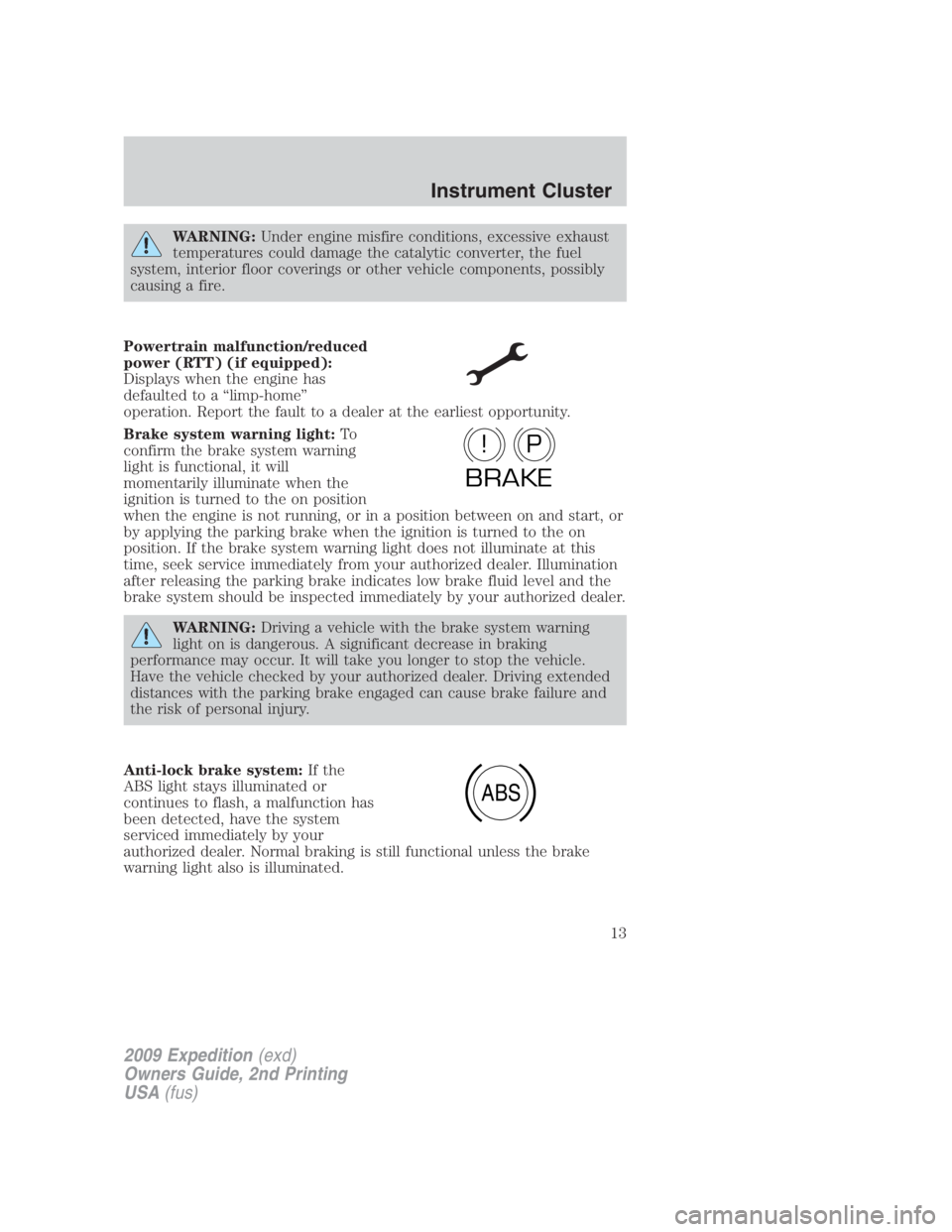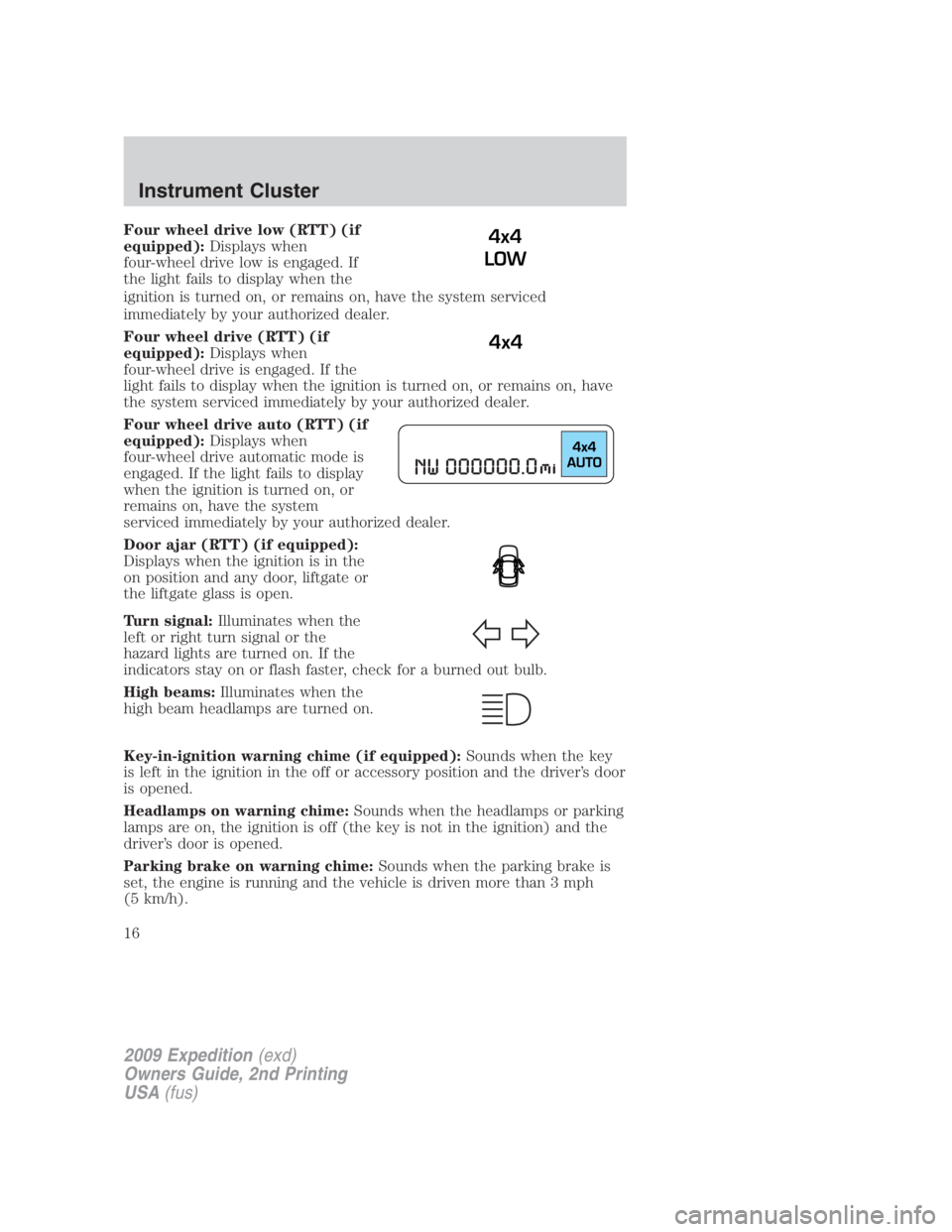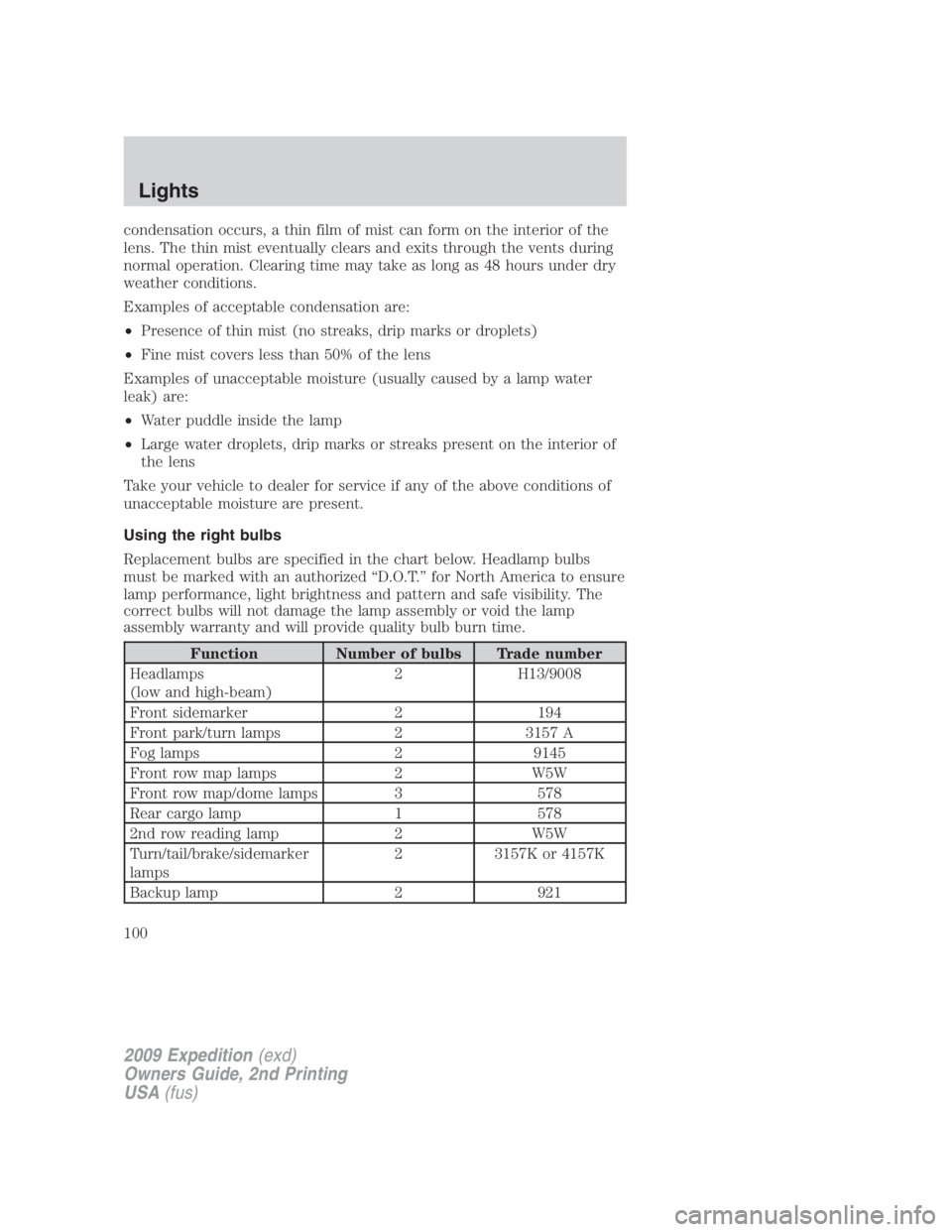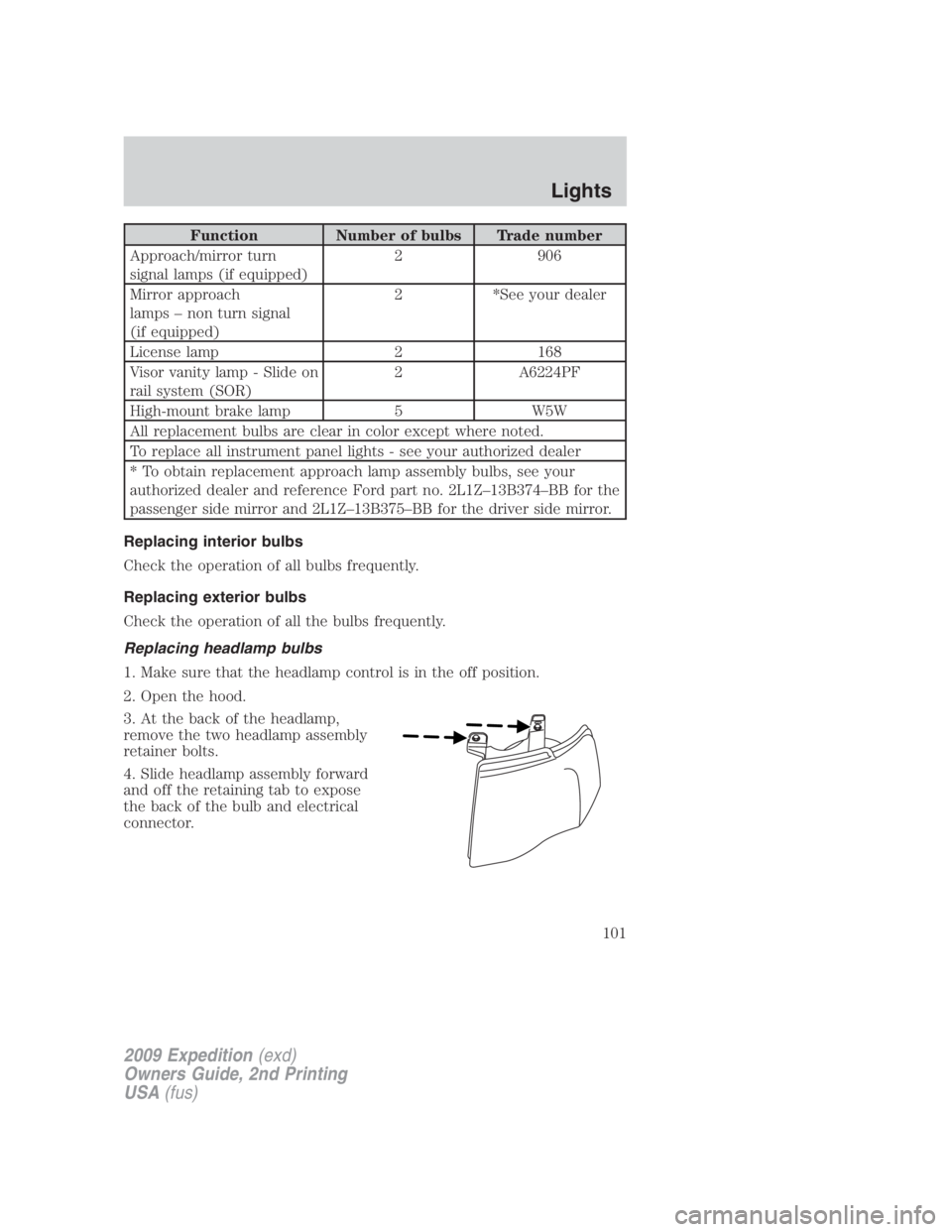Page 10 of 415
These are some of the symbols you may see on your vehicle.
Vehicle Symbol Glossary
Safety Alert See Owner’s Guide
Fasten Safety Belt Airbag - Front
Airbag - Side Child Seat Lower
Anchor
Child Seat Tether
Anchor Brake System
Anti-Lock Brake System Parking Brake System
Brake Fluid -
Non-Petroleum Based Parking Aid System
Stability Control System Speed Control
Master Lighting Switch Hazard Warning Flasher
Fog Lamps-Front Fuse Compartment
Fuel Pump Reset Windshield Wash/Wipe
Windshield
Defrost/Demist Rear Window
Defrost/Demist
2009 Expedition (exd)
Owners Guide, 2nd Printing
USA (fus)Introduction
10
Page 13 of 415

WARNING: Under engine misfire conditions, excessive exhaust
temperatures could damage the catalytic converter, the fuel
system, interior floor coverings or other vehicle components, possibly
causing a fire.
Powertrain malfunction/reduced
power (RTT) (if equipped):
Displays when the engine has
defaulted to a “limp-home”
operation. Report the fault to a dealer at the earliest opportunity.
Brake system warning light: To
confirm the brake system warning
light is functional, it will
momentarily illuminate when the
ignition is turned to the on position
when the engine is not running, or in a position between on and start, or
by applying the parking brake when the ignition is turned to the on
position. If the brake system warning light does not illuminate at this
time, seek service immediately from your authorized dealer. Illumination
after releasing the parking brake indicates low brake fluid level and the
brake system should be inspected immediately by your authorized dealer.
WARNING: Driving a vehicle with the brake system warning
light on is dangerous. A significant decrease in braking
performance may occur. It will take you longer to stop the vehicle.
Have the vehicle checked by your authorized dealer. Driving extended
distances with the parking brake engaged can cause brake failure and
the risk of personal injury.
Anti-lock brake system: If the
ABS light stays illuminated or
continues to flash, a malfunction has
been detected, have the system
serviced immediately by your
authorized dealer. Normal braking is still functional unless the brake
warning light also is illuminated. P!
BRAKE
ABS
2009 Expedition (exd)
Owners Guide, 2nd Printing
USA (fus) Instrument Cluster
13
Page 16 of 415

Four wheel drive low (RTT) (if
equipped): Displays when
four-wheel drive low is engaged. If
the light fails to display when the
ignition is turned on, or remains on, have the system serviced
immediately by your authorized dealer.
Four wheel drive (RTT) (if
equipped): Displays when
four-wheel drive is engaged. If the
light fails to display when the ignition is turned on, or remains on, have
the system serviced immediately by your authorized dealer.
Four wheel drive auto (RTT) (if
equipped): Displays when
four-wheel drive automatic mode is
engaged. If the light fails to display
when the ignition is turned on, or
remains on, have the system
serviced immediately by your authorized dealer.
Door ajar (RTT) (if equipped):
Displays when the ignition is in the
on position and any door, liftgate or
the liftgate glass is open.
Turn signal: Illuminates when the
left or right turn signal or the
hazard lights are turned on. If the
indicators stay on or flash faster, check for a burned out bulb.
High beams: Illuminates when the
high beam headlamps are turned on.
Key-in-ignition warning chime (if equipped): Sounds when the key
is left in the ignition in the off or accessory position and the driver’s door
is opened.
Headlamps on warning chime: Sounds when the headlamps or parking
lamps are on, the ignition is off (the key is not in the ignition) and the
driver’s door is opened.
Parking brake on warning chime: Sounds when the parking brake is
set, the engine is running and the vehicle is driven more than 3 mph
(5 km/h). 4x4
LOW
4x4
2009 Expedition (exd)
Owners Guide, 2nd Printing
USA (fus)Instrument Cluster
16
Page 100 of 415

condensation occurs, a thin film of mist can form on the interior of the
lens. The thin mist eventually clears and exits through the vents during
normal operation. Clearing time may take as long as 48 hours under dry
weather conditions.
Examples of acceptable condensation are:
• Presence of thin mist (no streaks, drip marks or droplets)
• Fine mist covers less than 50% of the lens
Examples of unacceptable moisture (usually caused by a lamp water
leak) are:
• Water puddle inside the lamp
• Large water droplets, drip marks or streaks present on the interior of
the lens
Take your vehicle to dealer for service if any of the above conditions of
unacceptable moisture are present.
Using the right bulbs
Replacement bulbs are specified in the chart below. Headlamp bulbs
must be marked with an authorized “D.O.T.” for North America to ensure
lamp performance, light brightness and pattern and safe visibility. The
correct bulbs will not damage the lamp assembly or void the lamp
assembly warranty and will provide quality bulb burn time.
Function Number of bulbs Trade number
Headlamps
(low and high-beam) 2 H13/9008
Front sidemarker 2 194
Front park/turn lamps 2 3157 A
Fog lamps 2 9145
Front row map lamps 2 W5W
Front row map/dome lamps 3 578
Rear cargo lamp 1 578
2nd row reading lamp 2 W5W
Turn/tail/brake/sidemarker
lamps 2 3157K or 4157K
Backup lamp 2 921
2009 Expedition (exd)
Owners Guide, 2nd Printing
USA (fus)Lights
100
Page 101 of 415

Function Number of bulbs Trade number
Approach/mirror turn
signal lamps (if equipped) 2 906
Mirror approach
lamps – non turn signal
(if equipped) 2 *See your dealer
License lamp 2 168
Visor vanity lamp - Slide on
rail system (SOR) 2 A6224PF
High-mount brake lamp 5 W5W
All replacement bulbs are clear in color except where noted.
To replace all instrument panel lights - see your authorized dealer
* To obtain replacement approach lamp assembly bulbs, see your
authorized dealer and reference Ford part no. 2L1Z–13B374–BB for the
passenger side mirror and 2L1Z–13B375–BB for the driver side mirror.
Replacing interior bulbs
Check the operation of all bulbs frequently.
Replacing exterior bulbs
Check the operation of all the bulbs frequently.
Replacing headlamp bulbs
1. Make sure that the headlamp control is in the off position.
2. Open the hood.
3. At the back of the headlamp,
remove the two headlamp assembly
retainer bolts.
4. Slide headlamp assembly forward
and off the retaining tab to expose
the back of the bulb and electrical
connector.
2009 Expedition (exd)
Owners Guide, 2nd Printing
USA (fus) Lights
101
Page 104 of 415
Replacing the high-mount brakelamp
To change the high-mount
brakelamp bulbs:
1. Remove the two screws holding
the lamp assembly in place.
2. Pull the lamp assembly straight
out.
3. Disconnect the wire harness.
4. Depress the four tabs that hold
the light assembly on, one at a time,
and pull the black bulb carrier away
from the lamp.
5. Pull the old bulb out and replace
with the new bulb.
6. Snap the black bulb carrier into
the lamp assembly.
7. Connect the wire harness.
8. Install the lamp assembly with
two screws.
Replacing fog lamp bulbs
1. From underneath the vehicle,
rotate the harness/bulb assembly
counterclockwise, to remove from
the fog lamp assembly.
2. Carefully disconnect the bulb
from the harness assembly via the
two snap clips.
Install the new bulb in reverse
order.
2009 Expedition (exd)
Owners Guide, 2nd Printing
USA (fus)Lights
104
Page 121 of 415
3. Press the SET + control and
release it.
4. Take your foot off the accelerator
pedal.
5. The indicator light on the
instrument cluster will turn on.
Note:
• Vehicle speed may vary momentarily when driving up and down a
steep hill.
• If the vehicle speed increases above the set speed on a downhill, you
may want to apply the brakes to reduce the speed.
• If the vehicle speed decreases more than 10 mph (16 km/h) below
your set speed on an uphill, your speed control will disengage.
Resuming a set speed
Press the RES (resume) control and
release it. This will automatically
return the vehicle to the previously
set speed.
2009 Expedition (exd)
Owners Guide, 2nd Printing
USA (fus) Driver Controls
121
Page 216 of 415

Deactivating/activating the Belt-Minder � feature (if equipped)
Read Step s1-4t horoughly before proceeding with the
deactivation/activation programming procedure.
The driver Belt-Minder � feature can be deactivated/activated by
performing the following procedure:
Before following the procedure, make sure that:
• The parking brake is set
• The gearshift is in P (Park)
• The ignition switch is in the off position
• The driver and passenger safety belts are unbuckled
WARNING: While the design allows you to deactivate your
Belt-Minder � , this system is designed to improve your chances of
being safely belted and surviving an accident. We recommend you
leave the Belt-Minder � system activated for yourself and others who
may use the vehicle. To reduce the risk of injury, do not
deactivate/activate the Belt-Minder � feature while driving the vehicle.
1. Turn the ignition switch to the on position. DO NOT START THE
ENGINE.
2. Wait until the safety belt warning light turns off (Approximately one
minute).
• Step 3 must be completed within 50 seconds after the safety belt
warning light turns off.
3. At a moderate speed, buckle then unbuckle the safety belt nine times,
ending in the unbuckled state. Step 3 must be completed within
50 seconds after the safety belt warning light turns off.
• After Step 3, the safety belt warning light will be turned on for three
seconds.
4. Within approximately seven seconds of the light turning off, buckle
then unbuckle the safety belt.
• This will disable the Belt-Minder � feature for that seating position if it
is currently enabled. As confirmation, the safety belt warning light will
flash four times per second for three seconds.
• This will enable the Belt-Minder � feature for that seating position if it
is currently disabled. As confirmation, the safety belt warning light will
flash four times per second for three seconds, followed by three
2009 Expedition (exd)
Owners Guide, 2nd Printing
USA (fus)Seating and Safety Restraints
216